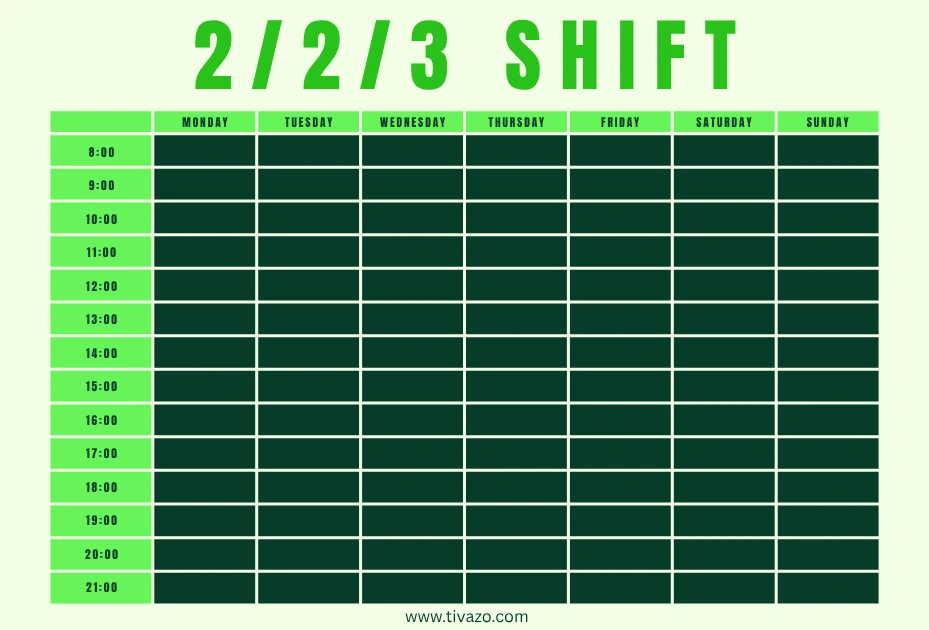Have you ever wondered where the efficiency comes from for hospitals, factories, or the police to handle everything exactly as scheduled on all days, even holidays? It all boils down to the way you schedule your sessions.
In many 24/7 industries, the 2 2 3 shift is both very practical and commonly used. It ensures everyone is looked after, but also allows them time away from their employer. That’s why it is attracting more interest these days.
Also known as the Panama schedule, the 2 2 3 shift method helps prevent burnout and makes sure operations run all the time. This system offers employees schedule stability, plus more time off, and gives employees breathing room in demanding areas. This article will explain how the 2 2 3 shift operates, its benefits, challenges, and different variations of it to work for teams.
You May Also Like: Getting Started with the 5/25 Warren Buffett Rule: The Key to Better Productivity
Key Highlights:
- Industries Using the 2 2 3 Shift
- Advantages of the 2 2 3 Shift Schedule
- Challenges of the 2 2 3 Shift Schedule
- Different Variations of the 2-2-3 Shift Schedule
- Difference Between The Variations of the 2 2 3 Shift Schedule
What Is the 2 2 3 Shift Schedule?
Employees on this schedule work 2 days nonstop, take 2 days off, and then work 3 days straight before going on their next set of 2 days off. Usually, employees work 12 hours, providing coverage around the clock.
Because of its advantageous features, this method is used by healthcare, manufacturing, and emergency services. Frequent breaks and longer intervals keep exhaustion away, help people manage their personal and work lives well, and boost productivity in 24-hour operations.
For two weeks, the schedule usually follows this order:
Week 1: 2 days work, 2 days off, 3 days work.
Week 2: 2 days off, 2 days work, 3 days off

Afterward, this process starts once more. Different organizations require employees to alternate their 12-hour shifts between days and nights.
You May Also Like: Guide To 4Ds of Time Management – When and How to Use?
Industries Using the 2 2 3 Shift
Many production industries that remain busy every day use the 2 2 3 shift schedule. Due to smart timetabling, these sectors can ensure their work stays on schedule and that their employees get enough rest.
1. Healthcare Facilities
Once you’ve been in a hospital, you can see that it never rests. To keep healthcare teams ready around the clock, most facilities use the 2 2 3 shift pattern. Healthcare workers often work long days, yet this setup allows them regular time to rest, which benefits their performance and patient care. By using on-call coverage, hospitals can ensure their staff isn’t overworked.
2. Manufacturing Plants
In manufacturing, equipment is run continuously to accomplish production tasks. It’s the 2 2 3 shift schedule that really stands out in these circumstances. Because of working in shifts, workers can manage the facility 24 hours a day. With this planning, production lines are efficient, workers do not get overworked, and everyone remains safe in the process.
3. Law Enforcement Agencies
Staff and officers with the police force are required to respond at any time of day or night. By working a 2 2 3 shift, they find time to rest and unwind between working long hours. Having this schedule, officers can depend on days off, which helps them focus under pressure. Thanks to this, departments keep public safety constant and avoid straining their teams.
4. Fire Departments
Because firefighters respond to uncertain situations, planning their work shifts is necessary. The good thing about the 2 2 3 shift is that it gives firefighters long shifts and enough break time to rest before the next one. Because of this, they are always prepared to act as soon as needed. Keeping a schedule where tasks rotate is fair to everyone, which improves morale and the way the crew works as a team.
5. Utility Services
Electricity and water continue to work properly, pushed by utility workers every hour, or weather conditions. With the 2 2 3 shift, someone is always present to handle urgent or emergency issues, all the time. This way, workers are available almost all the time, but they also have moments to catch their breath. Using this method, services can remain dependable, and staff can remain content.
Using this schedule, all three kinds of plants ensure there is always someone working and help prevent employees from getting too exhausted. If your team works non-stop, learning what works best for them regarding the schedule is very helpful.
You May Also Like: Pomodoro Technique For Work: Reason To Use, How To Do It
Advantages of the 2 2 3 Shift Schedule

Implementing the 2 2 3 shift schedule offers several benefits for both employers and employees:
1. Enhanced Work-Life Balance
Alternating their days off lets employees take more days away, allowing them to plan their lives and avoid burnout.
2. Consistent Coverage
For employers, the schedule keeps businesses running smoothly around the clock, doesn’t overwork staff too much, and preserves their ability to provide quality service.
3. Reduced Overtime
Good planning in a 2 2 3 shift allows organizations to reduce last-minute overtime, which saves money and improves the well-being of staff.
4. Improved Employee Morale
Making breaks regular and scheduling them the same way each time boosts happiness at work and can cause more workers to stay.
Challenges of the 2 2 3 Shift Schedule

While the 2-2-3 shift schedule has numerous advantages, it also presents certain challenges:
1. Long Working Hours
Employees work 12-hour shifts, which can be physically and mentally demanding, potentially leading to fatigue if not managed properly.
2. Disrupted Sleep Patterns
Rotating between day and night shifts can interfere with circadian rhythms, affecting sleep quality and overall health.
3. Scheduling Conflicts
Despite its predictability, the schedule may still conflict with employees’ personal commitments, necessitating flexible shift-swapping policies.
4. Adaptability Issues
As organizational needs evolve, the fixed nature of the 2-2-3 schedule may require adjustments to accommodate changes in staffing requirements.
Different Variations of the 2-2-3 Shift Schedule
Several adaptations of the 2 2 3 schedule exist to meet specific operational needs. Here is a detailed explanation of each variation.
1. Panama Plus Shift Schedule
Instead of rotating through 12-hour shifts every other day, the Panama Plus Shift Schedule offers shorter 8 or 10-hour rotations. The shift still separates workdays from rest days, but tries to make work hours shorter to help reduce tiredness. Businesses interested in keeping a round-the-clock watch and boosting employee energy often depend on working an evening shift.
2. Pitman Shift Schedule
A Pitman shift means you work 24 hours on and 24 hours off in blocks of 4 days, with each shift normally lasting up to 12 hours. Longer breaks for employees are needed to rest and heal after hard workdays. The purpose is to give people plenty of time off to keep them healthy while they are working hard.
3. DDNNOO Schedule
Day-Day-Night-Night-Off-Off (DDNNOO) is the shortened version of the well-known 2 2 3 shift work pattern. They work two days during the day, then two nights, and then enjoy two days without work. With this schedule, people see when they will work, making it easier for them to balance life and jobs, as well as giving the hospital around-the-clock coverage. Industries that change shifts between day and night will find it valuable because it helps keep these switches clear.
4. Dupont Shift Schedule
On the Dupont model, workers split their hours with a 28-day cycle, alternating 12-hour shifts with longer days off. In some cases, employees work many successive night shifts and have long spans for rest and personal use after the end of their shift. Such a schedule is desirable for organizations that want staff to have long breaks and full coverage of all shifts.
These variations of the 2 2 3 shift schedule show how flexible the model can be, adapting to different industries’ needs and helping businesses maintain continuous operations while considering employee rest and productivity.
Difference Between The Variations of the 2 2 3 Shift Schedule
| Shift Schedule | Shift Length | Cycle Length | Work-Rest Pattern | Common Industries | Key Feature |
| Panama Plus | 8 to 10 hours | 14 days | Rotates 2-2-3 with shorter shifts | Healthcare, Manufacturing | Shorter shifts to reduce fatigue |
| Pitman | Up to 12 hours | 8 days | 4 days on, 4 days off | Emergency services, Fire Dept | Longer rest periods after work |
| DDNNOO | Typically 12 hours | 6 days | 2 day shifts, 2 night shifts, 2 off | Various 24/7 operations | Simple, predictable day/night rotation |
| Dupont | 12 hours | 28 days | Mixed shifts with longer off blocks | Manufacturing, Utilities | Longer cycle with extended rest |
Best Practices for Implementing the 2 2 3 Shift
To maximize the benefits and mitigate the challenges of the 2-2-3 shift schedule, consider the following best practices:
1. Engage Employees in Scheduling Decisions
Forming team members’ schedules together can have a big effect when using a 2 2 3 shift schedule. As they understand their own needs, inviting staff to share ideas means fewer problems and an uplift in mood. Feeling appreciated by others helps staff stick to their assigned schedule. If people choose their own shifts, it’s more likely they’ll be on time and work hard.
2. Promote Healthy Sleep Habits
Moving from days to nights and back in a 2 2 3 shift schedule can cause problems with your body clock. For this reason, encouraging healthy sleep habits matters the most. Help your team set up a place where they can sleep undisturbed and in darkness, and advise them to get and stick to similar routines every day. Telling them to skip caffeine late in the day and to use dark curtains in their rooms can improve their energy levels at work and give them a better quality of sleep. Getting enough sleep helps you pay better attention and make fewer mistakes at work.
3. Provide Adequate Breaks
Many bakers struggling with 12-hour 2 2 3 shifts find rest breaks very important for combating fatigue. Offer employees opportunities to rest for a little while, stretch, snack, or breathe during the workday. Taking a few short breaks allows them to rest and avoid getting too tired during long work. It’s a simple change that can greatly boost productivity and make the job feel better, especially if your shifts are tough.
4. Monitor Employee Well-Being
Watching how your team functions is very important while implementing the 2 2 3 shift schedule. Having regular talks and offering surveys to your team can help find out if anyone is feeling too stressed, worn out, or unhappy with how they use their time. When managers are concerned about employee well-being, they can find problems early and solve them early on. When workers feel healthy and happy, they will be more productive and need less time off because of illness.
5. Utilize Scheduling Software
Doing a 2 2 3 shift schedule without the right assistance is challenging. This type of software deals with rotating schedules, records time off, and updates the workers’ list whenever anything changes. It makes the process less likely to create mistakes and frees up managers’ time. Furthermore, most of these tools enable employees to manage their time off or work schedules on their own. Thanks to technology, the process goes very smoothly without causing stress.
Employing these practices helps firms benefit from the 2 2 3 shift schedule, maintain their employees’ health and engagement, and continue to handle around-the-clock business duties.
Conclusion
The 2 2 3 shift schedule offers a balanced approach to continuous operations, benefiting both employers and employees. By understanding its structure, advantages, challenges, and variations, organizations can implement this schedule effectively, promoting productivity and employee well-being.
What is the healthiest shift pattern to work?
The healthiest shift pattern is usually day shifts with consistent hours, allowing for regular sleep and meal schedules. If rotating shifts are necessary, forward-rotating schedules (moving from day to evening to night shifts) with adequate recovery time between shifts are generally considered healthier. Adequate sleep, light exposure during the day, and consistent routines can help reduce stress and fatigue.
What are the negatives of 12-hour shifts?
While 12-hour shifts can mean more days off, they also come with downsides:
Fatigue and burnout, especially over consecutive days.
Limited time for family, meals, and relaxation on workdays.
Higher risk of mistakes due to long periods of concentration.
Negative impact on sleep quality and social life if not properly managed.
Why are 12-hour shifts better than 8 hours?
Some employees and employers prefer 12-hour shifts because
Workers get more full days off, often leading to better work-life balance.
It reduces the number of shift handovers, which can lower the chances of miscommunication.
It can be cost-effective for employers in terms of reduced overlap and administrative time.
However, such shifts must include enough rest and proper scheduling to maintain health and productivity.




